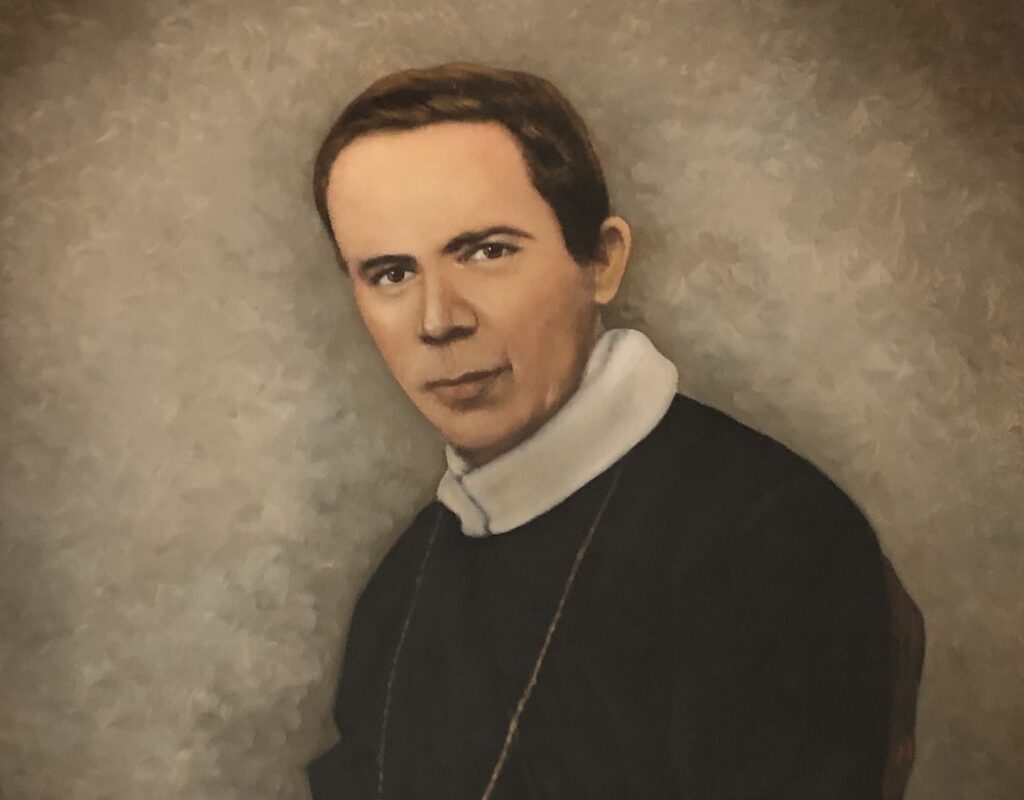ST. JOHN NEUMANN
A SAINTLY MISSION FOR GERMAN CATHOLICS
Catholics in Virginia were outsiders from the beginning. Native Americans of the Chiskiack tribe killed a group of Spanish Jesuit missionaries near present-day Williamsburg (1571). During Virginia’s time as an English colony and for the first years of American independence, there were few Catholics in the territory because their religion was outlawed (1607–1786).
Around the turn of the 19th century, Irish and French Catholics began arriving in Virginia. They remained the predominant ethnic groups in the Catholic Church during the first two decades of the Diocese of Richmond (1820–1840).
The construction of the James River and Kanawha Canal brought significant numbers of German laborers, including some Catholics, to Richmond (1840–1842). The canal, which was originally proposed by George Washington, sought to provide a water route from Richmond, across the Allegheny Mountains, to the Ohio River (1820–1851). The project was only partially completed and was eventually superseded by railroads.
German Catholics in Richmond worshipped at St. Peter’s Church but had difficulty understanding and speaking English. Father Timothy O’Brien, the pastor of St. Peter’s, encouraged the German community to form a separate parish. He and a German parishioner, Henry Müller, asked the Redemptorist religious order in Baltimore to send a priest to minister to the German community on an occasional basis (1842).
In response, the Redemptorists sent Father John Nepomucene Neumann (1811–1860), himself a German-speaking immigrant from Bohemia (then part of the Austrian Empire, today in the Czech Republic). Neumann had been an energetic pastor to German immigrants in New York state (1836–1840) before joining the Redemptorists in Pittsburgh (1840–1842).
He made his religious profession in Baltimore and was assigned there at the time of his brief mission to Richmond (1842). Neumann was later appointed the bishop of Philadelphia (1852) and was the first American bishop to be canonized (1977).
In September 1842, Father Neumann preached an eight-day mission to German Catholics at St. Peter’s Church, Richmond. At this time, the community was taking steps to form its own parish under the patronage of the Virgin Mary and was supported in its efforts by Richard V. Whelan, the second bishop of Richmond (1841–1850).
Germans worshipped each Sunday at St. Peter’s, but quarterly, and then monthly, they attended a Mass in the basement of the church celebrated by a Redemptorist who preached in German (1843–1848). During this time, the German community collected funds in hopes of being able to support a resident priest and to build a church.
In 1848, the German community received a resident pastor and rented a building in Richmond that it used as a chapel. A church, named St. Mary’s, was built and dedicated three years later (1851), and a parochial school followed (1852). The parish also established St. Mary’s Cemetery (1874), which was renamed Holy Cross Cemetery (1924).
In addition to the Redemptorists, various religious orders served the German community at St. Mary’s: Jesuits from Georgetown (1850–1860) and Benedictines from Latrobe, Pennsylvania (1860–1937), supplied pastors, while school was staffed by the School Sisters of Notre Dame from Baltimore (1859–1868) and then by the Benedictine Sisters from St. Mary’s, Pennsylvania, who eventually started another motherhouse in Bristow, Virginia (1868–1913).
As German immigrants settled in other parts of Virginia, St. Mary’s initiated two missions that eventually became parishes themselves: Immaculate Conception in Buckner’s Station, today Buckner (beginning in 1869), and Sacred Heart in Meherrin (beginning in 1904).
With the German Catholic community in Richmond growing and assimilating into the wider culture, its members moved farther west and began joining other parishes. At the request of Augustine van de Vyver, the sixth bishop of Richmond (1889–1911), the Benedictines opened a parish for German Catholics as St. Benedict’s (1911), which included a military high school (today Benedictine College Preparatory) and later a parochial school run by the Benedictine Sisters.
Bishop Van de Vyver’s plan was to close St. Mary’s once the older generation of Germans died. In 1937, Peter L. Ireton, then the coadjutor and administrator of the diocese (1935–1945) and later its ninth bishop (1945–1958), closed St. Mary’s. The site became the headquarters of the Diocesan Mission Band, which preached and celebrated Mass in the rural areas of the diocese.
St. Mary’s was one of the few national parishes in the Diocese of Richmond, which for the most part did not experience the influx of Catholic immigrants that northern areas of the United States did. Significantly, the work of men and women religious, beginning with St. John Neumann, helped the diocese to meet the pastoral needs of the German community that grew substantially in Richmond.
Benedictine Father Ignatius Remke, who grew up in St. Mary’s Church and was its last pastor, explained the impact of St. John Neumann’s mission to German Catholics in his “Historical Sketch of St. Mary’s Church: Richmond, Virginia, 1843–1935” (1936):
The Redemptorist Provincial sent to Richmond Rev. John Nepomucene Neuman [sic]… This very pious and zealous priest… arrived in Richmond in September, 1842, and in St. Peter’s Church gave a mission for the Germans. The mission lasted eight days. During the mission, Father Neuman [sic] gathered together all the German Catholics in the city and vicinity and succeeded in getting them to approach the sacraments. Before leaving the city, he promised that in the future a German priest would hold services here every three months. …
Father Neuman [sic]was the first priest in Richmond who gave a mission and held divine services exclusively for the Germans. We [St. Mary’s Church] therefore feel honored and blest to have had as our first spiritual father, this saintly priest.

